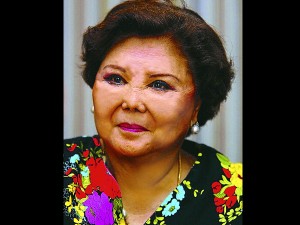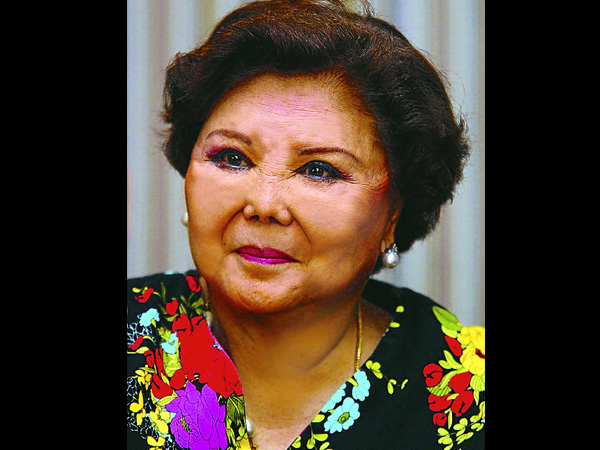
CLAUDE TAYAG
A couple of years back, Tayag was so disturbed by a piece in The Los Angeles Times that described Filipino food as still “assimilating” into the scene, too diverse to have an identity, or “brown, oily and unappealing.” He wrote the paper in defense of Filipino cuisine: “I would like to stress that having such a diverse culinary heritage certainly puts the Filipino at an advantage. Filipino food offers so much variety and nuances in taste and flavor and the diversity is an asset rather than a liability…”
And to the Fil-Am chef who said that Filipino food is not appealing, Tayag begged to differ: “I beg to disagree. It is only as unappealing, brown, oily, and fried as one makes it. I’ve eaten some really greasy… food in Los Angeles and New York. Go deeper South within the US and you would find some of the greasiest grub on the planet. I invite Ms. Gore to come to Manila and I will personally treat her to some of the most gorgeously-prepared toothsome Filipino dishes here, far from the unappealing stewed, brown, oily and fried fare of her recollection.”
The wiser ones have taken up this offer, visited Bale Dutung and left impressed. No less than THE Tom Parker Bowles, son of HRH Prince Charles’ second wife Camilla Parker Bowles, and more importantly, Food Editor of Esquire UK, was won over by Tayag’s cooking. He writes in Esquire UK, quoting Tayag: “Now the general complaint is that Filipino food is brown and oily… But that’s just not true. Look at what you’ve eaten today. I use the freshest ingredients and make it look good. And I’m hoping more people will take as much care of the presentation, and the cooking, too. Find the time, do it properly. Don’t take short cuts. This is how we must change. Make it look appetizing, sell its virtues.”
Similarly, food host/writer/chef Anthony Bourdain was impressed and made this observation about Pampango cooking after being inducted into it by Tayag: “There is a flavor spectrum going on here that is different (from) anywhere else I’ve been.”
GLENDA BARRETTO
Way before Claude Tayag, there was Glenda Barretto. Her legacy is even older than our 1987 Constitution because she was in Malacañang as personal chef to then President Ferdinand Marcos. In fact she was Mrs. Marcos’ protégée. When Mrs. Marcos would come back from her state visits abroad, she would tell the young Chef Glenda, “Ganito lang ang ginawa nila…” and relay to her the combined simplicity and elegance of the fancy state dinners she attended.
The now renowned Balut Caviar in Barretto’s restaurant Via Mare was first served in Malacañang. Mrs. Marcos, Barretto recall, would get a kick out of watching her guests’ reactions once they realized that what they just ate was balut!
Decades later, Barretto remains the authority on Filipino food. If you’d like to have a Filipino-themed dinner party, Via Mare remains top of mind. Even at the vin d’honneur of President Noynoy Aquino, Barretto was chosen to cater “because then they’d be no more learning curve,” host Bettina Osmeña explained.
NORA DAZA
Now even way before Barretto was Nora Daza, the Philippines’ Julia Child who studied under Simone Beck and Louisette Bertholle, Child’s co-authors in her book “Mastering the Art of French Cooking.” Daza also dazzled audiences with her own television shows, teaching generations of housewives and food lovers how to cook. Our parents grew up watching “At Home With Nora” and “Cooking It Up With Nora”; and many a bride got the cookbook “Let’s Cook with Nora” (published 1969) whose recipes my own mother swears by to this day.
Daza opened the first “authentic” French restaurant in the country, Au Bon Vivant, and opened the first Filipino restaurant in France, Aux Iles Philippines. This was way back in 1970.
MARGARITA FORES
What Daza was to French cooking, Margarita Fores has been, albeit much later, to Italian cuisine. This petite morena single-handedly introduced real Italian cooking to the Filipino masses via Cibo, the not-so-fast food Italian chain that Fores started in the 1990s. Suddenly everyone knew the meaning of al dente and started ordering items like penne al telefono, Bolognese and linguini instead of just the usual spaghetti.
Aside from expanding Cibo, Fores has also created fine dining establishments such as Pepato (sadly, no longer around) and Lusso in Greenbelt 5, developed the catering service Cibo di M, and even ventured into becoming a designer/luxury florist with her brand Fiori di M Food and Floralscapes.
Looking forward, Fores will also help Ambassador Luca Fornari and the Italian embassy bring the Artusi legacy to the Philippines. The Artusi legacy is a priceless compendium of information on Italian cuisine and culture. To immerse herself in this, Fores recently spent a day at Casa Artusi in Forlimpopoli, outside Bologna, learning about Pellegrino Artusi, his book, the cooking school, restaurant and library that is his legacy to his hometown.
She’s also networking with Organic Produce Farmers, producers and purveyors from around the Philippines, especially Negros Occidental, Bukidnon, Tagaytay, Batangas and Laguna to put together a bountiful pool of sources to share with other restaurant owners and chefs. She explains, “I feel the need to convince others of the benefits of choosing organic and at the same time have lots of produce to choose from for our Grace Park menu, the farm-to-table, seed-to-plate little place soon to open in Rockwell! Have been trying to make Cibo 100 percent organic and I’m happy to say we are now over 70 percent organic in our local vegetable usage!
Finally, one of Fores’ latest projects is the food at the Mind Museum as her corporation has been tasked as this museum’s in-house caterer.
SONJA OCAMPO
Ocampo is on this list because of one product: cupcakes! While bazaars the previous year had variety, when Cupcakes by Sonja opened, suddenly every stall had its version of cupcakes to sell on top of its usual product list. Soon even wedding cakes were being offered in the form of layered cupcakes. Today Ocampo’s shop has become a landmark at Serendra and her cupcakes the must-have dessert after dining at the other establishments. Thankfully, she has plans to open more branches soon. She also currently teaches younger generations how to make this addictive dessert at Enderun Colleges. (Visit cupcakesbysonja.com)
FELICE STA. MARIA
Felice Sta. Maria is writer first, foodie second. But her writings on things gastronomic are nothing short of amazing. “The Governor-General’s Kitchen” explores historical menus and recipes and takes the reader on a culinary journey that starts as far back as 1521. Her research for this book took her to various provinces and she was even able to discover a dinuguan recipe from 1913, adobo recipes from 1851, and a sinigang recipe from 1922. Last December she published another book called “The Foods of Jose Rizal” which explores what the hero cum writer cum biologist cum doctor ate. It brings one back to the time of Rizal and makes the world he lived in accessible via the universal language of food. Sta. Maria is now working on “Philippine Culinary Word Book”—a Filipino food dictionary—not only to define each dish that we cook or the ingredients that we use but more importantly, to provide a historical reference for it all. She envisions that “when the Word Book comes out, we will all be on more solid ground.”
Recently, Sta. Maria also gave a talk at the San Francisco Asian Art Museum on the history of Philippine cuisine. It was the first time that Philippine cuisine was presented in that framework. Hopefully she will convert her presentation into a book as well for the rest of us to learn from.
REGGIE ASPIRAS
Reggie Aspiras has legions of fans, thanks to her column “Kitchen Rescue” on Thursdays in the Inquirer Lifestyle Section. She continues to give tips on cooking and to share her experiences in the restaurants she has visited. She has since published book versions of her column, but remains down to earth and hilarious despite their commercial success. When I asked her how many copies she had sold, she replied, “Alam mo naman, God is good… Eh, kaya sobrang dami (So many)!”
MARKETMANILA
Marketmanila is a writer-researcher on steroids: a post a day. And I don’t mean a blurb, a rant or a “the-world-revolves-around-me” kind of post. His blog posts contain facts, geographical and historical references, and product comparisons of his subjects. And he has output on a daily basis! With his sharp photos and level of writing, it’s no wonder his blog gets around 15,000 to 20,000 hits a day. He was one of the first food bloggers—back when it was fun—along with Rants and Raves, Tennis and Conversations and 80 Breakfasts. And his clout (or should I call it, cult?) has only grown. Though he seems to have mellowed down, sometimes allowing a few days to lapse between posts, his following continues to grow—even as his name remains a mystery.
THE LADIES (AND GENTLEMAN) BEHIND SALCEDO MARKET
(Barangay Captain Nene Lichauco, Salcedo Market Committee members Patricia Lichauco, Des Torres and Mia Villanueva, Women of Bel-Air Carminda Regala, Ofelia Lopez, Bella Oposa, Catherine Turingan, Elena Lorayes, and the gentleman who got it rolling, Marc Medina)
First there were Christmas bazaars. Then there was the weekend market. It all started in the mid-2000s when Nene Lichauco, Chairman of Bgy. Bel-Air, simply wanted the Salcedo Village community to know that they were part of the Bel-Air Barangay. Instead, what was born was a weekend community market that went beyond Salcedo Village, beyond Makati and even beyond the Philippines. It has become so popular that it is now included in the to-do list of tourists. The wait-list for a stall is long, with hundreds on it. Other weekend markets have since emerged in various villages but Salcedo Market remains the market to go to for the best selection of produce and a great sense of community a barangay chairman could only hope for.
DOREEN’S ANGELS: MICKY FENIX AND MYRNA SEGISMUNDO
My foray into food writing started when I responded to a newspaper ad for a food writing contest. I had just started a tsokolate business and wanted my inspiration, Nana Meng, to be included in the book they were publishing. The contest was the Doreen Gamboa Fernandez Food Writing Awards. The mission of this effort is to encourage aspiring writers to dive into the world of food writing and develop a passion for cultural anthropology by exploring our culinary heritage. The encouragement received by the younger generation of food writers including myself, Christine Nunag, Ige Ramos and Joy Subido, has been tremendous, thanks to these ladies. And the only way that we can pay them back is to grow as writers in this field that we love. Micky Fenix and Felice Sta. Maria are now in the process of completing the manuscript for a “best of” edition. With the quality of writing that has been coming in, I’m sure it’s a most challenging task. But needless to say, these women continue to make Doreen Fernandez proud and the next generation inspired. •









































